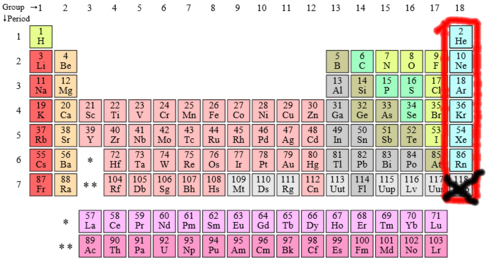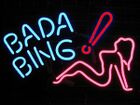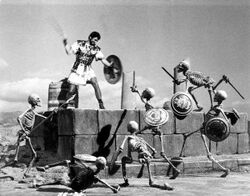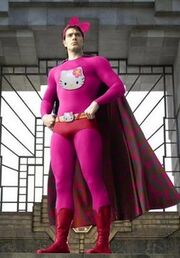Noble gases

The noble gases are chemical elements that, as of 1969, are listed in group 18 of the periodic table. Under their original natural condition, they were all odorless, colorless, and unreactive, and thus safe for children. In layman's terms, they were all boring. However, they were developed through experimentation to make them usable in interesting and unnatural ways. This is why the noble gases are now restricted to group 18 of the periodic table.
The six noble gases that occur naturally are helium (helion) (He), neon (Ne), argon (Ar), krypton (Kr), xenon (Xe), and radon (Rn). The one that occurs unnaturally cannot be listed here due to Uncyclopedia's compliance with the National Security Agency's current Prudery Policy. The six natural noble gases are all named after noble beings or the possessions or animal companions of noble beings in Greek, Roman or Japanese mythology. Contrary to common thought, these six gases all have uses appropriate for children. Except neon.
Helium (helion)
The first and lightest noble gas on the periodic table is used to fill balloons for two primary reasons. First, helium is lighter than air, meaning the gas will raise the balloon; and second, unlike the hydrogen that leaked from the floating airship Hindenburg, it doesn't explode over New Jersey.
Helion (later named helium) was named after the Greek sun god Helios (Greek Ἥλιος). It would have been named after the Roman sun god Sol Invictus, but nobody wanted an element named Sol Invictuson.
The gas' original name "helion" was changed to "helium" to avoid confusion with "hellion," which is a person (especially a child) who raises hell. This change was initiated in 1969 by the Faithful Against Gas Society formed by the First Baptist Church of Janustown, Texas. (For more on the Anti-Gas Movement, see the anti-gas groups Maalox, Imodium and Gas-X).
There are three primary purposes for helium balloons:
1. Decorations for birthday parties and bar mitzvahs when the hostess cannot think of anything creative. This is its only child-appropriate use.
2. Blimps built to float above sports arenas advertising Goodyear.
3. Lifting units enabling Larry Walters to float 15,000 feet up in his lawn chair over the beach city of San Pedro, California, in order to spy on young Latina girls sunbathing topless.
Helium is also sometimes inhaled in an attempt to sing extremely high falsetto notes like the singer Mariah Carey. Instead, the inhaler usually sounds more like Mickey Mouse on crack.
Neon
The second noble gas was used to make lights beginning in the 1920s, although these became less popular after the Anti-Gas Movement of 1969.
Neon is named after the Japanese Divine Elemental HERO Neos (Japanese 日本語). Neos is described as a bright warrior being who both guards and advertises adult establishments.
From the 1920s to 1960s, there were three primary purposes for neon lighting:
1. Signs for cheap motels (especially ones with hourly rates).
2. Signs for "art film" movie theaters and bars.
3. Signs for clubs where middle-aged men could watch young Latina girls dancing topless.
Contrary to common thought, there is no child-appropriate use for neon. The young Latina girls are not that young.
Argon
The third noble gas Argon (Greek Ἀργώ) was named after the ship Argo used by the Greek group Jason and the Argonauts. The group, popular with both girls and their mothers, used the Argo to sail from lolcos for both their original 1263 concert and their 1313 50th anniversary reunion tour in Mongolia. Argon's mother Haimash Khatun had been a supporter of the group.
Argon aka Arghun Khan was the fourth noble ruler of the Mongol empire's Ilkhanate, ruling from 1284 to 1291. After the death of Argon's favorite wife Bolgana, he wanted her younger sister Kökötchin, a dancer, as a replacement. Kökötchin, like all young Mongolian girls, was required to have her feet bound, making dancing difficult. (And required to have her breasts bound, making her dancing less entertaining.)
While she traveled across Asia in a caravan led by the Venetian Marco Polo, Polo told her that Venetian and Greek girls, unlike the girls of Mongolian, were not required to bind either their feet or their breasts. And Greek dancing girls received better hourly rates. Kökötchin decided to break her arranged engagement to Argon, fled the caravan, traveled to Greece, and married the drummer of Jason and the Argonauts.
Why Argon is considered a gas is unknown.
Krypton
The fourth noble gas Krypton is a element that fell to Earth in 1938 after the planet of the same name exploded due to a hydrogen leak. The planet's residents, called Kryptonians, had named their world after the Greek mythological noble canine Krypto (equivalent of the Roman mythological noble canine Pluto).
Krypton (Greek κρυπτός) is the only noble gas that, when combined with another material under specific conditions, can form a solid compound. Millerite, a nickel sulfide mineral, will begin to melt if heated to exactly 1,467 °F (797 °C). If bubbles of krypton are released into the melting millerite, the primary byproducts are crystals of varying color and a yellowish bubbling liquid with a low caloric content. The crystals are known as kryptonite, and the liquid is known as Miller Lite beer.
While the green form of kryptonite is the most damaging to Kryptonians, pink kryptonite (Supergirl vol. 4 #79, April 2003) turns Kryptonians into homosexuals, and periwinkle kryptonite (Superman Family Adventures #9, March 2013) causes Kryptonians to lose all inhibitions. The combination of pink and periwinkle led to the creation of the popular parties known as Gay Bashes.
Red kryptonite (Adventure Comics #252, Sept. 1958) causes bizarre behavior and bodily transformations. This is the form most commonly used by preteens. Red kryptonite is the only explanation for the otherwise unexplainable transformation known as puberty.
Xenon
The fifth noble gas is named after the Greek heroine Xena (Greek ξενα). The planet later known as Eris was also named after her. Xena was a warrior princess who formed a duo with her battle companion (and, after an all-you-can-drink beer bash, lover) Gabrielle.
Xena beheaded the Greek Goddess Eris (known to the Romans as Discord) not because the diety snuck pink and periwinkle into the duo's beer, nor because the goddess got planet Xena renamed Eris, but because Xena discovered Discord had created Disco music.
After Xena proved to the public that Discord had created disco, the planet Eris was demoted to a dwarf planet along with planet Pluto. This did not make Pluto very happy.
The element Xenon is used in flash lamps (by flashers), arc lamps (by projectionists in movie theaters to show "art films"), and as a general anesthetic (by flashers to calm girls from exposing the flashers' exposure to girls in movie theaters).
Radon
The sixth noble gas Radon is named after the Japanese thunder and messenger god Raiden (Japanese 雷神) who played drums for the band Jason and the Argonauts. He also played drums to fill the air with his important messages, and is thus the namesake of radio which fills the air with important messages. Raiden also beat his drums to attract young Mongolian girls.
The element radon is radioactive, meaning it can be used to actively transmit radio signals. It was used in tubes for radio and television until its use was discontinued a few years after the Anti-Gas Movement of 1969. Because of this movement, people became bloated with gas, had trouble sleeping and couldn't stay still. This led to the 1970s popularity of all-night discotheques and disco music broadcast on radio.
Interestingly, disco singers could only sing their high falsetto notes while inhaling helium. This explains while they all sounded like Mickey Mouse on crack.
Interactive Periodic Table
To research other elements, press a link in the table below. Or don't, your choice.
| H | | He | |||||||||||||||
| Li | Be | | B | C | N | O | F | Ne | |||||||||
| Na | Mg | | Al | Si | P | S | Cl | Ar | |||||||||
| K | Ca | Sc | Ti | V | Cr | Mn | Fe | Co | Ni | Cu | Zn | Ga | Ge | As | Se | Br | Kr |
| Rb | Sr | Y | Zr | Nb | Mo | Tc | Ru | Rh | Pd | Ag | Cd | In | Sn | Sb | Te | I | Xe |
| Cs | Ba | Lu | Hf | Ta | W | Re | Os | Ir | Pt | Au | Hg | Tl | Pb | Bi | Po | At | Rn |
| Fr | Ra | Lr | Rf | Db | Sg | Bh | Hs | Mt | Ds | Rg | Cn | Nh | Fl | Mc | Lm | Ts | Og |
| | |||||||||||||||||
| La | Ce | Pr | Nd | Pm | Sm | Eu | Gd | Tb | Dy | Ho | Er | Tm | Yb | ||||
| Ac | Th | Pa | U | Np | Pu | Am | Cm | Bk | Cf | Es | Fm | Md | No | ||||
See also
| Featured version: 14 August 2015 | |
| This article has been featured on the main page. — You can vote for or nominate your favourite articles at Uncyclopedia:VFH. | |





